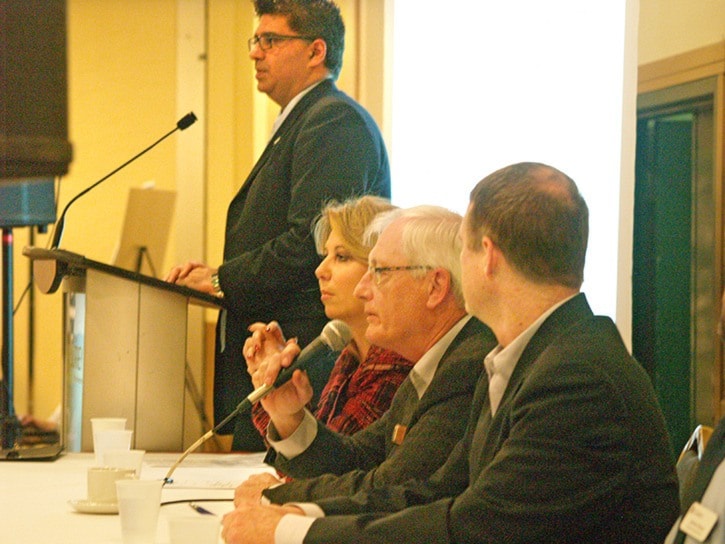An apparent step back from BNSF-route relocation by members of Surrey council won’t affect White Rock’s moves in that direction, according to Mayor Wayne Baldwin.
Responding to comments made this week by Surrey Mayor Diane Watts and Coun. Mary Martin that promoting safety of the existing line is Surrey’s main priority, Baldwin said White Rock will continue to present its case for realignment of the route to federal and provincial authorities in the new year.
“Whatever they say doesn’t change what I want to do,” Baldwin said. “Hopefully, we keep everybody onside and start locally.”
An alternative to the waterfront line would still be “the ideal solution” to White Rock’s rail-safety issues, he said, noting it was the City of Surrey that most recently raised the long-discussed “rails to trails” concept as part of the community rail forum it hosted Nov. 26.
“They had a visual depiction of what it might look like,” Baldwin said. “It’s a great vision of what might be.”
But, Baldwin also acknowledged, “the main thing we’re trying to do is get dangerous goods off the waterfront.”
“The most likely trigger points for derailment are in Surrey but because of the length of trains, (a derailment) is going to affect us.”
Ultimately, he said, relocation of the main BNSF route would be an issue between the federal government and BNSF, which owns the property on which the line is located.
“All we can do is do what we can do,” he said, adding that White Rock must ensure its views and wishes about the tracks are heard.
“We’re honour-bound to do that,” he said.
Meanwhile, a U.S.-based advocate for improved passenger-rail service between Portland, Ore. and Vancouver says the feasibility of a Blaine stop should be included in analysis of realignment of the BNSF route in White Rock and South Surrey.
Bruce Agnew, director of Seattle-based Cascadia Center, said he is writing to both the City of White Rock and the City of Surrey to ask that they include the Gateway Semiahmoo (Blaine station) initiative in future discussions of realigning the route.
“We’re asking them to reach out to Whatcom County and the City of Blaine and bring them into the planning process,” Agnew said, adding it could strengthen the case for realigning the route on both sides of the border.
He said he plans to include details of Surrey and White Rock’s discussion of realignment in a future presentation to Whatcom County by Cascadia and Gateway Semiahmoo.
Agnew said that realignment of the route could significantly improve travel time for the 37 miles between Vancouver and the border, which would make it more attractive to BNSF, and increase the likelihood of the Washington State Department of Transportation allowing a passenger stop in Blaine.
“One of the concerns of WashDOT was that a Blaine stop would add a few minutes to the schedule... if the travel time was better between the border and Vancouver, that would make up for it.”
A realigned route would also solve some other problems for BNSF, including the continued potential for slides along the hillside bluffs on the current route.
“Reliability would improve, which is one of the requirements of Amtrak,” Agnew said, adding that some $800 million has been invested in improvements to the rail corridor between Portland and Blaine.
“They say that, with that money, they need to improve the service.”
In that context, Agnew said, it would make sense to spend money realigning the route north of the border.
“Cascadia has long argued that the folks in B.C. need to invest in the corridor,” he said.
Realignment would not impact on Blaine Station plans, or the line south of Peace Arch Park, he added, provided it followed a route parallel to Hwy. 99.
“The route would go through Peace Arch, but instead of curving around to White Rock it would go with the 99,” Agnew said.
He noted that while a 2002 Delcan study of alternative rail alignments (commissioned by Surrey) identified other, more inland routes, these would be much more costly to construct.
Co-ordinating realignment with the Gateway Semiahmoo initiative would benefit business on both sides of the border, Agnew said, as well as providing both local Canadian and U.S. residents with access to Amtrak passenger service.
“It incorporates a bunch of strategies,” he said. “Our goal would be to have people stay in the area; to take advantage of the tourism aspect.”
In addition to encouraging visitors to stay in the Semiahmoo Bay, it would also open the door to Canadian communities such as White Rock and Crescent Beach, he said, while removal of the rail line from the waterfront would also make possible an extended esplanade from Blaine to Crescent Beach and beyond.
